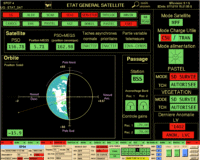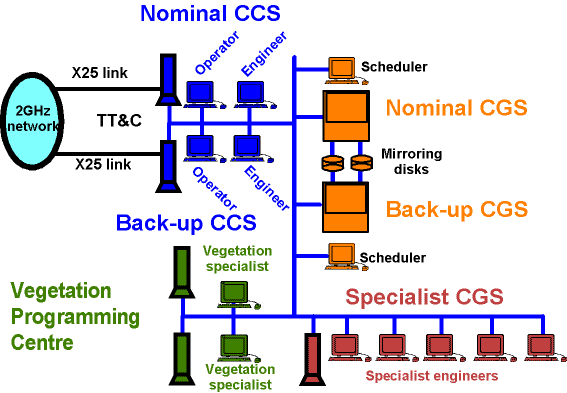Design concept
Capabilities
Hardware and
software architecture
Exchanges
From 1998, the SPOT 4 satellite will provide continuity of service as part of the
SPOT family of earth observation spacecraft. These services began in 1986 with the
launching of SPOT 1.
Like its predecessors, SPOT 4 will be managed from the Toulouse space centre
operated by the French space agency CNES. More specifically, CNES will control the
satellite bus plus its passengers and the main payload comprising two HRVIR imaging
instruments.
From the moment it is placed in orbit by the Ariane launcher and throughout its
five-year lifetime, the satellite will be controlled by the SPOT operations control
centre, or CMP (from the French "Centre de Mise et Maintien à Poste").
top of page, article
The SPOT operations control centre, or CMP, was designed and developed by CNES to meet
the requirements of various spacecraft using the same satellite bus as SPOT 4. The
centre's capabilities can be briefly described as follows:
- simultaneous control of two SPOT satellites,
- manned by just one person during routine operations, thanks to high-level automation,
- hardware and software designed for a service life of 13 years.
Software development began in 1990, with CNES awarding contracts to companies in
France, Italy and Belgium.
The CMP software suite was developed using C, C++, Fortran and Ada. The complete suite
represents some 600,000 instructions.
top of page, article
The CMP comprises three separate entities performing three distinct roles :
- Receives housekeeping telemetry downlinked by the
satellite. This consists of physical quantities (currents, voltages, temperatures, status
data, etc.) measured by onboard instruments, then converted into digital telemetry
parameters. At the CCS, each parameter is converted back to a physical quantity then
compared with its allowed range of variation or, in the case of a status, with the allowed
status.
- Presents telemetry parameters on monitors, display panels and mimic diagrams as physical
quantities, plots, symbols, and so forth, using colour to indicate the status of each
(i.e. normal or out-of-range).
- Receives tracking data from the TT&C stations, including
satellite range, antenna pointing angles and Doppler shift data, which together determine
the satellite's position in space.
- Sends commands to the satellite to adjust its
attitude or position on its orbit, manage onboard equipment, or program the imaging
instruments.
The CCS is designed to perform all of these operations simultaneously.




Mimic panels
(each enlargement : about 60 K)

Mimic panels displaying equipment status
(animated sequence : about 808 K)
- The housekeeping management centre,
or CGS, handles all off-line processing of housekeeping telemetry. The CGS software suite
analyses and archives incoming housekeeping telemetry and prepares commands to be uploaded
during subsequent satellite passes. The tasks performed by the main CGS subsystems
include:
- Satellite attitude and orbit control : this subsystem analyses the
tracking data to determine and update the parameters describing the satellite's orbit, then programs the satellite's attitude
control system. This subsystem also monitors the satellite's orbital parameters to
predict and compute any orbit correction
manœuvres.
Every day, the adjusted orbital parameters are used to generate pass prediction ephemeris
data (one pair of position-velocity data points every 3 minutes) which, in turn, are used
to program the onboard missions and determine precisely when the satellite will be within
range of the different TT&C stations.
Using satellite telemetry, this subsystem also updates the relationship between the
onboard computer's clock and universal time (UTC) to ensure that all commands are
accurately time-and-date coded.
The orbital parameters and the relationship between onboard time and UTC are distributed
to all SPOT system entities twice a day.
- Monitoring of onboard equipment and software. The subsystem performing
this task is the most critical in that it is the only one that can generate the commands
to recover from an onboard equipment or flight software failure. More
specifically, this subsystem is used to investigate equipment failures, switch over to
backup equipment, manage the onboard computer's memories and make changes to the flight
software. Although it plays only a minor role during routine operations, it is vital
during critical ones. This subsystem demands particularly thorough validation.
- Engineering database. This database stores all engineering data on the
satellite's behaviour throughout its entire service life. This includes archives
containing all housekeeping telemetry downloaded by the satellite, all commands uploaded
to it, and all activities at the CMP since it was launched. The engineering database
subsystem includes tools for querying the archives and sophisticated software for
analysing telemetry parameters. The subsystem generates monthly reports summarizing the
behaviour of each item of onboard equipment (operating time over the last month, operating
time since launch, predicted operating time over next year, next five years, etc.). In a
word, this database is the engineering memory of the satellite's life in orbit.
- Optical instrument command generation. During routine operation, programming centre generates the HRVIR work program for the coming
day, then relays it to the CMP's optical instrument command generation subsystem. This
subsystem checks the work program to ensure that the necessary payload resources are
available and compliance with rules concerning viewing modes, including Pastel operating modes, mode sequences, equipment operating modes,
and so forth.
In certain cases (typically during engineering investigations), the optical instrument
command generation subsystem can even generate a work program directly, then check its
compliance with the payload and equipment operating rules. The subsystem also generates
the image telemetry reception plan to go with each payload workplan. Last but not least,
the subsystem generates statistics on payload utilization for both short- and long-term
monitoring purposes.
- Programmed acquisition checkout. This subsystem gathers data form all
entities contributing to imagery acquisition, from programming
centre programming to onboard acquisition and reception by the direct receiving stations
through to archiving by the archiving and
preprocessing centre. By comparing the imagery programmed and that actually acquired,
this subsystem can track down system anomalies (failure of a direct receiving station,
satellite failure, etc.). The programming centre is kept fully informed of all shortfalls
so it can reprogram any missing scenes.
- Passenger programming and control. The SPOT 4 passengers are also managed by the CMP, some demanding more
attention than others.
Doris and Poam III are controlled by
a dedicated ground segment that handles all programming. For these passengers, the CMP's
role is confined to monitoring and supervision.
Pastel, the ESBT package, Pastec and the radar transponder demand considerably more CMP
attention and are controlled in much the same way as other items of onboard equipment.
Pastel is special in that it is used as a resource for HRVIR payload programming. Here,
the CMP is one of the chain of items involved in allocating and programming HRVIR payload
resources.
Similarly, the ESBT package is used as an additional resource for transmitting
housekeeping telemetry for the CMP's own needs. Here too, the CMP is one of the chain of
items involved in programming the ESBT.
Pastec gathers data recorded by several experiments. Here, the CMP programs the
experiments while taking into account Pastec's data recording capacity and the resources
available for data transmission. This involves planning over several days at a time.
A dedicated subsystem interfaces the Doris, Poam, Pastel and ESBT passengers with the
corresponding ground segments (transmission of housekeeping data, activity management and
forecasting, checking of incoming commands).
- The Vegetation programming centre, or CPV,
handles the programming of the Vegetation instrument.
In coordination with the Vegetation system operator, the CPV
generates daily workplan commands telling the instrument what imagery to acquire. The
daily workplan takes into account the Vegetation mission programming requirements,
engineering-type programming needs, and system capabilities.
The CPV also compiles the detailed workplan for the main Vegetation
receiving station in Kiruna, Sweden (SRIV), which is used to download the data stored
in Vegetation's memory, hence to free the memory for further imagery acquisition.
All of these activities involve regular exchanges with widely-scattered centres making
up the SPOT 4 system, including:
- the HRVIR programming centre operated by Spot Image, the system's commercial operator,
- the main SPOT receiving stations located in Toulouse, south-west France and Kiruna in
far northern Sweden,
- main Vegetation imagery receiving station in Kiruna (SRIV),
- the SPOT archiving and preprocessing centres in Toulouse and Kiruna,
- the Doris and Pastec control centres in Toulouse, the Pastel control centre at Redu in
Belgium and the Poam control centre in Albuquerque, in the United States,
- the Vegetation image processing and archive centre (CTIV) and the Vegetation system
operator in Mol in Belgium.
These entities use two additional subsystems that are also vital for the CMP:
- the first provides communications between the entities, centralized automatic activity
management, time recording, and so forth,
- a database, developed using Oracle, contains descriptions of all data exchanged with the
satellite (telemetry, commands and flight software) plus descriptions of all processing
operations needed for data interpretation (monitoring conditions, formulas for computing
parameters, etc.).
top of page, article

Satellite control centre (CCS)
The CMP hardware architecture is designed around Hewlett-Packard Series 9000 computers running under Unix.
All the CMP computers are interconnected via an Ethernet network.
 The satellite control centre, or CCS, uses an H-P 9000/735 controlled through an X terminal (for command
transmission and telemetry reception). Four additional X terminals can be connected to the
CCS computer to display telemetry parameters on mimic diagrams. For the SPOT 4 CCS,
the operations engineers require just one X terminal.
The satellite control centre, or CCS, uses an H-P 9000/735 controlled through an X terminal (for command
transmission and telemetry reception). Four additional X terminals can be connected to the
CCS computer to display telemetry parameters on mimic diagrams. For the SPOT 4 CCS,
the operations engineers require just one X terminal.
A second CCS computer using the same configuration is ready
to take over should the nominal computer fail.
top of page, article
Housekeeping management centre (CGS)
The housekeeping management centre, or CGS, comprises three computers:
- An H-P 9000/K250 to handle the routine activities of
the different subsystems plus a work sequencing monitor to automatically control the
different CMP machines. This work sequencing monitor is programmed every day via an X
terminal.
- An H-P 9000/735 dedicated to non-routine activities with
five X terminals on which satellite, orbit determination and other specialists can prepare
special operations.
- A third computer, an H-P 9000/K250, is used as a spare,
ready to stand in whenever either of the others needs maintenance.
top of page, article
Vegetation programming centre (CPV)
The Vegetation programming centre, or CPV, comprises two computers:
- An H-P 9000/735, complete with two X terminals, dedicated to
operational activities and mission studies;
- A second computer, with the same configuration, ready to
take over should the nominal computer fail. This computer is also used to distribute
processed telemetry parameters.
top of page, article
The CCSs are linked to the 2-GHz TT&C network via two X.25 lines operating at 19
200 baud.
Data exchanges between the CMP machines use NFS.
All exchanges with SPOT 4 centres outside Toulouse use an FTP-based common
communications protocol.
top of page, article

page updated on the 00-06-06






